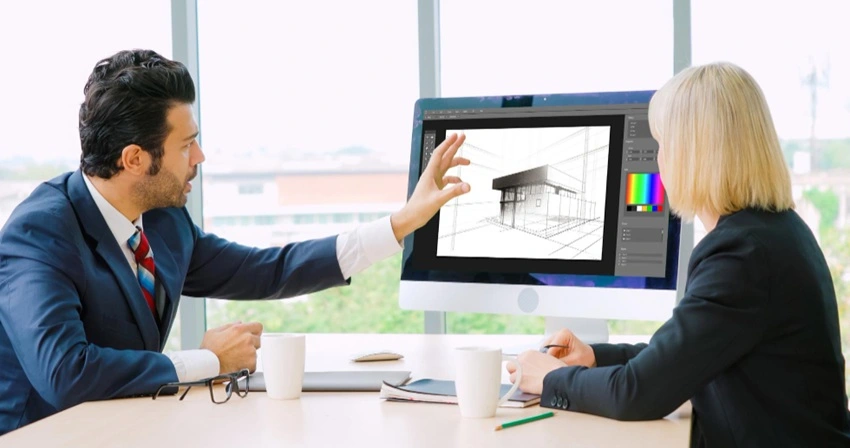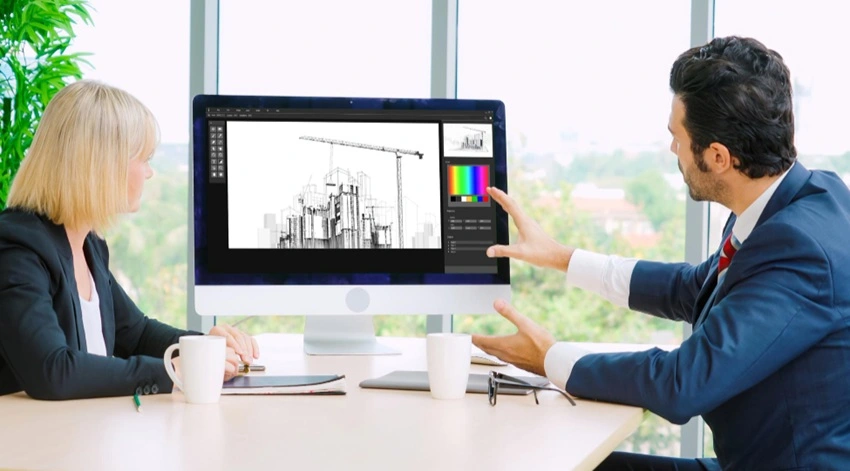Table of Contents
Architects, engineers, and contractors (AEC) commonly use Revit, a widely used building information modeling (BIM) program. The need for experienced Revit experts is growing as more and more AEC companies use Revit. You need to be well-versed in the capabilities and functionality of the program if you’re getting ready for a Revit job interview. We’ve put together a list of the top 10 Revit interview questions and answers in this post to assist you get ready for the interview.
Download Popular Interview Questions for Revit Architecture Specialists PDF,
Why is Revit Important in the AEC Industry?
Before we get into the Revit interview questions, lets just take a quick look at why Revit has become such a fundamental tool in the architecture, engineering and construction industry. Revit – a product of Autodesk – is a Building Information Modeling (BIM) software that’s used to design and document buildings. But it’s more than just another CAD programme, its fully integrated data-driven design features let professionals create accurate 3D models, manage building systems and run complex analysis that would be a real challenge in traditional CAD software.
As BIM becomes the go to approach in the industry, the demand for people who are good with Revit is really starting to pick up. In fact a lot of construction and electrical firms are actively on the lookout for Revit experts now, because they know that having someone on board who can get the most out of Revit means they can streamline their workflows, get their projects bang on target and save a pretty penny in the process.
Popular Interview Questions for Revit Architecture Specialists
To help you get ready for your interview, here are the ten most common Revit architecture interview questions and their responses:
Q1. Explain what is Revit Architecture?
Ans: Revit Architecture is able to deliver dynamic information in intelligent models allowing complex building structure to be designed accurately and document it in a short span of time. Each intelligent model created with Revit Architecture signifies an entire project and is stored in a single database file.
Q2. List the file types used in Revit architecture?
Ans: File types in Revit architecture are
.RVT : Revit Project Files
.RFA : Revit Family Files
.RTE : Revit Template Files
.RFT : Revit Family Template Files
Q3. Explain how you can define a level in Revit architecture?
Ans: When you create a new project in metric, using the startup page, it will use your default template.
It will show a dialog box, in which you have to choose a template “DefaultMetric.rte.”
There are two levels of a default in Revit. Add one more level, rename the level and open the north view
To add more level apart from the default, go to the main menu and activate the level from the ribbon inside datum section
For inserting new level, you can draw lines, or you can pick lines
Q4. Describe the steps involved in creating a floor in Revit Architecture.
Ans: The “Sketch” program must be used to draw a floor. We must follow a set of actions to accomplish that.
First, we must activate our file and the first-floor plan. Then click on view.
Then we choose the floor tool option from the home tab’s ribbon.
Our plan will now appear half-toned, allowing us to merely observe it and use it as a guide for a floor sketch.
The designer needs to specify the boundary by sketching.
One may design a floor using drawing tools like rectangles, circles, and lines. Additionally, they can simultaneously make it to the other level.
Q5. Describe the X-ray mode modification technology for Revit Mass.
Ans: Revit Mass in X-ray mode can be altered.
First, we click the mass to pick it after opening the Revit mass family. A new contextual tab will appear.
Now activate the X-ray mode by clicking the Revit ribbon. Eventually, Revit mass is visible as a see-through image with clear mass sub-objects. You can see through the mass because the tips are more significant.
An individual can choose “Add Profile” from the Revit ribbon if there is any requirement to add a profile. To activate it, click “Add Profile.”
Moving the cursor to the mass, we examine the profile’s preview before adding it. When we believe the profiler is in the proper position, click the mouse.
Dragging the points, edges, and surface will allow someone to fine-tune the mass.
Q6. What do you understand about templates in Revit?
Ans: Templates in Revit are used to create new projects with a predefined set of settings and content. This can be helpful in ensuring that all projects conform to company standards, or in simply creating a starting point that is tailored to the needs of a specific project. When creating a template, you can choose which content and settings to include, and which to leave out.
Q7. What is the purpose of project parameters?
Ans: Project parameters are a way of customizing a Revit project to fit the specific needs of a project. They can be used to add information that is not typically included in a Revit project, such as the name of the architect or the construction company. Project parameters can also be used to change the way that certain elements appear in a Revit project, such as the size or color of walls.
Q8. What do you understand about levels in Revit? How can they be used to improve workflow?
Ans: Levels in Revit are a way of representing different floors or heights in a building model. They can be used to improve workflow by helping to organize the model and keeping track of different elements on different levels.
Q9. Explain how you can add structural columns in Revit Architecture?
Ans: In order to add structural columns in Revit Architecture you have to place the columns at specific grid intersections, now
- Double click level 1 in the project browser
- In the home, ribbon tab click the pulldown for column and select structural column
- Now for the type of column choose the concrete-regular column of 300X450 mm
- Place the column of A1, making sure that the grid lines are purple when placing. It will confirm that the column is in the center of the two grid lines
Q10. Explain how can you add a custom label in Revit Sheets?
Ans: To add a custom label in Revit sheets, open a dialog box
- Go to the home tab, select label in the text panel
- Click the place where you want to place the label. This will open a dialog box
- Select to add a new parameter
- Another dialog box opened, click select
- Select your shared parameters and then click OK
- Click OK again until you see the edit label, the only dialog box opened
- Repeat the steps until you have enough labels for the sheet
Q11: How are Revit Architecture, Revit Structure and Revit MEP different?
Ans: Revit Architecture, Revit Structure, and Revit MEP are three different Revit software platforms for different aspects of a building’s lifecycle:
- Revit Architecture for building design and construction, walls, windows, doors, floors.
- Revit Structure is utilized primarily for structural components, including columns, beams, foundations, and load-bearing walls.
- Revit MEP is used mailny mechnical, electrical, plumming systems, HVAC, water, lighting, fire protection
These three platforms mesh in a BIM environment, for cross-disciplinary collaboration.
Q12: What is “Worksets” in Revit?
Ans: Worksets in Revit are used to divide a model into sections so multiple users can work on the same project at the same time without conflicts. Worksets are used in large projects where the architectural, structural, MEP teams are working in different locations. They help:
Optimize performance by managing what parts of your project are exposed to the users at a time.
Let team members work in independent worksets without stepping on each others’ feet.
Worksets are key in collaborative BIM workflows, particularly in multi-disciplinary teams.
Q13: How do you deal with MEP coordination clash in Revit
Ans: Clash detection is one of the main reasons for using Revit in construction. So when you experience a conflict, here’s what to do:
- Locate the clash in either Revit’s native clash checking tools or Navisworks (for cross-discipline models).
- Work with the team (structural, MEP, architecture) to determine the optimal solution, whether it’s rerouting pipes, shifting ducts or resizing equipment.
- Tweak the model and modify it to capture the solution.
- Double-check the clash and make sure it’s fixed.Record the modifications for future recall.
Your capacity to solve these problems quickly can be time and resource saving for the project.
Q14: What is a ‘Family’ in Revit and how is it different from a ‘Component’
Ans: In Revit, a Family is a collection of elements with similar parameters and behavior. Families can be:
System Families – Walls, floors, roofs, etc., that are part of Revit’s basic system.Loadable Families: Doors, windows, furniture and custom elements you make/import.
A Component is an instance of a Family that is inserted in a project (e.g. window into wall).
Q15: How do I make custom parameters in Revit?
Ans: To create custom parameters in Revit:
- Open the Project Parameters dialog from the Manage Tab.
- Click Add to add a new parameter.Choose the type of parameter (e.g., text, length, area).
- Assign the parameter to a category (walls, doors, windows, etc.).
- Once created, you can then assign the parameter to your model components and plan it.
Custom parameters enable you to capture project-specific data that is not captured as part of Revit’s default information.
Master MEP Design with Industry-Leading Training!
Gain in-depth knowledge of Mechanical, Electrical, and Plumbing (MEP) Design with expert-led courses. Learn HVAC, fire safety, sustainable building strategies, and BIM applications to excel in the construction industry.
Know MoreWhat Interviewers Are Really Checking for
Before diving into questions, understand what the interviewer wants:
- Practical usability of Revit: Can you use the software, not just know it exists?
- BIM workflow awareness: Worksets, linking models, collaboration, cloud sharing.
- Technical depth + problem‑solving: How you handle real modelling issues, errors, rework.
- Communication and team mindset: Revit work often lies in coordination, your ability to interact matters.
- Adaptability to newer versions & tools: 2026 workflows include cloud collaboration, multi‑discipline linking, MEP/structural integration.
With this in mind, your answers should reflect not only “I know Revit” but “I can use Revit to deliver real project value.”
Final Words
Preparing for a Revit interview requires a strong understanding of core features, such as families, worksharing, scheduling, and sustainability tools. By familiarizing yourself with common interview questions and hands-on practice, you can increase your chances of landing a job in the AEC industry.
If you’re looking to boost your Revit skills, Entri App offers a comprehensive Revit course with expert-led training, real-world projects, and certification. Start learning today and take your career to the next level!
Master MEP Design with Industry-Leading Training!
Gain in-depth knowledge of Mechanical, Electrical, and Plumbing (MEP) Design with expert-led courses. Learn HVAC, fire safety, sustainable building strategies, and BIM applications to excel in the construction industry.
Know MoreFrequently Asked Questions
Q1. What is Autodesk Revit, and how is it different from AutoCAD?
Answer: Autodesk Revit is a Building Information Modeling (BIM) software used for architectural design, structural engineering, MEP, and construction. Unlike AutoCAD, which is a drafting tool, Revit allows for parametric modeling and real-time collaboration.
Q2. What are the main features of Revit?
Ans: Answer: Key features of Revit include: Parametric Components (intelligent 3D modeling) Worksharing (collaborative multi-user environment) Family Creation (customized reusable components) BIM 360 Integration (cloud-based coordination) Schedules & Quantities (automated reports)
Q3. Explain the difference between Revit Families and Components.
Answer: Families are pre-built or custom-designed elements (e.g., doors, windows, furniture). Components are instances of these families placed in the Revit model.
Q4. How does Revit handle collaboration among multiple users?
Answer: Revit uses Worksharing, where a central model is shared among users via Worksets. Users create local copies and synchronize changes with the central file, ensuring real-time collaboration.
Q5. What is a Revit Template (.RTE), and why is it important?
Answer: A Revit Template (.RTE) is a pre-configured starting point containing default settings, views, families, and standards, helping maintain consistency across projects.















